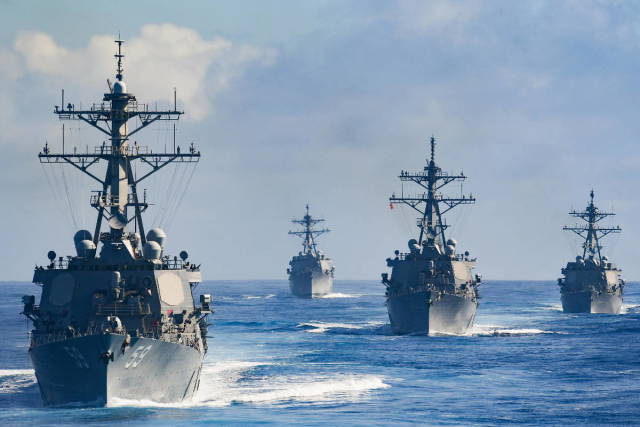Destroyers are one of the most powerful tools in the Navy's arsenal to ensure constant combat capability at sea. As some of the world's leading naval powers invest in new destroyers over the next few decades, planners will have to chart a course between the introduction of new technologies and the risk of timely commissioning of future large surface warships.
 |
| Harry Lye. |
| Source: invoen.ru |
Harry Lye is a senior reporter on the naval subject of the resource, studying programs, requirements for destroyers of the future and the possibilities of promising technologies.
New destroyer programs: the four best
One of the most famous Western programs is the development by the US Navy of a new URO destroyer, currently known as DDG(X). The new platform, according to Admiral Mike Gilday, Chief of Naval Operations (CNO), will be larger than the ubiquitous Arleigh Burke-class destroyers (DDG-51), but smaller than the widely maligned ships of the Zamvolt project (DDG-1000).
The US Navy established the DDG(X) program in the summer of 2021. Its management was instructed to develop an acquisition strategy, a design and technical package, a plan for the construction of ships, their testing and deployment to the fleet, and draw up support plans.
According to a representative of the Naval Naval Systems Command: "This guided missile destroyer will provide the flexibility and margin of safety necessary to become the successor of the DDG-51 type as the next stable large surface ship of the fleet, combining elements of the DDG-51 Flight III combat system with a new hull shape, an efficient integrated power system and with greater endurance, reducing the burden on fleet logistics."
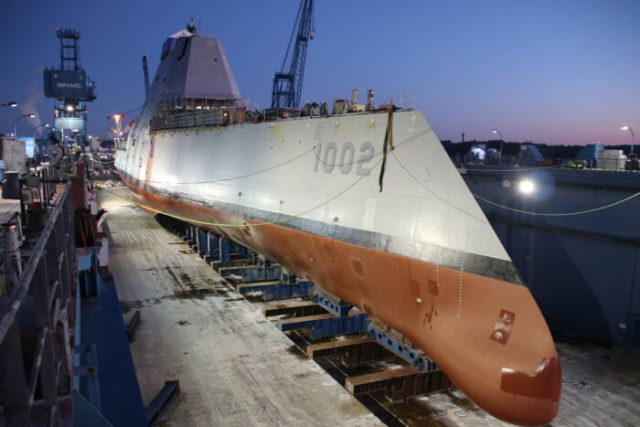
The destroyer of the Zamvolt project on the slipway
He also added that during the 2021 fiscal year, the U.S. Navy began working with Arleigh Burke shipyards, probably General Dynamics Bath Iron Works and Huntington Ingalls Industries Ingalls Shipbuilding division, to achieve CNO goals for "cost, time and productivity." Preliminary design work on DDG(X) will begin in fiscal year 2022.
As previously reported, the construction of 11 destroyers of the DDG(X) project will provide one ship for each of the large aircraft carriers of the US Navy, and the purchase of 22 will provide a similar replacement for the aging Ticonderoga-type cruisers. Another option would be to continue production of DDG(X) to replace the oldest ships of the Arleigh Burke project of the US Navy.
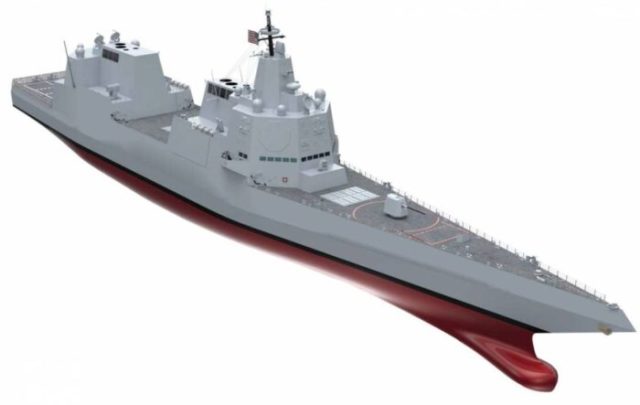
The concept of the new DDG(X) destroyer of the US Navy
Across the ocean, next [probably 2023], the UK will officially begin the concept development and evaluation phase of its efforts to replace the Type 45 destroyer in service in the 2030s. Work on the future Type 83 as part of the broader Future Air Defense System program will include the development of the ship, new sensors and weapons systems.
Commenting on the Type 83 at a hearing before the Parliamentary Defense Committee, Vice Admiral Chris Gardner, General Director of Ships at Defense Equipment & Support [a trade organization under the UK Ministry of Defense], said: "The Type 83 or future air defense system — again, we are in the foothills trying to start exploring what is the space to meet the future needs of the Royal Navy. I can't say at all, hand on heart, today that I have a clear idea of what it's going to be.…Apart from the fact that we need to take the potential that we have today and decide how we will develop it to make it usable in the future, which increasingly depends on the system rather than the platform."
Elsewhere in Europe, in its multi-year defense planning document for 2021-2023, Italy committed to a short-term project of two new destroyers, designated DDX. The future 10,000-ton destroyers, starting in 2028, will replace the ships of the Luigi Durand de la Penne type of the Italian Navy. The tender for the construction of the ships is likely to be announced in 2023, and the Italian company Fincantieri is expected to build new ships.
In 2020, South Korea also announced a competition for the design of its new destroyer under the KDDX program, which will provide the Republic of Korea Navy with six additional missile defense destroyers. Construction of the KDDX is scheduled to begin in 2024, the displacement of the ship is expected to be no more than 8000 tons.
South Korea's KDDX destroyer
Old and new
Looking at the ships of the future, and in particular DDG(X), Bill Guarini, head of business development at Raytheon Missiles & Defense, said that future surface warships will include improved traditional and "many" new capabilities. He added that for programs like DDG(X), new technologies must be mature to minimize the risks of costs and schedules in the future.
As hypersonic missiles are developed and other threats emerge, the U.S. Navy, like many other navies around the world, is seeking to use similar weapons and invest in directed energy capabilities, the latter of which is sparking talk about future energy requirements.
"With the expansion of unmanned and autonomous systems, vehicles and vessels, future surface warships will include the ability to provide command and control of an unmanned fleet. The architecture of the Navy's distributed maritime operations will allow the use of longer—range ship effectors," B. Guarini noted.
"The growing number and characteristics of submarines worldwide create a resurgent need for improved anti-submarine warfare systems such as the AN/SQS-62 variable depth sonar, improved MK54 light torpedoes and a reliable multi-domain anti-submarine network."
As for lethality, Guarini said high-precision hypersonic weapons such as a conventional fast strike would give commanders "fast long-range capabilities" that defeat and deter opponents.
Hypersonic weapons are increasingly attracting the attention of the military in terms of developing their own weapons and the ability to resist them, which, according to B.Guarini, will require "a distributed and integrated network of sensors and effectors to create a multi-level protective chain of weapons."
He added that the layered defense will rely on existing missiles such as the SM-6, directed energy weapons and new interceptors such as the interceptor with a planning phase. Currently, in addition to hypersonic missiles, there is still a need for advanced cruise missiles.
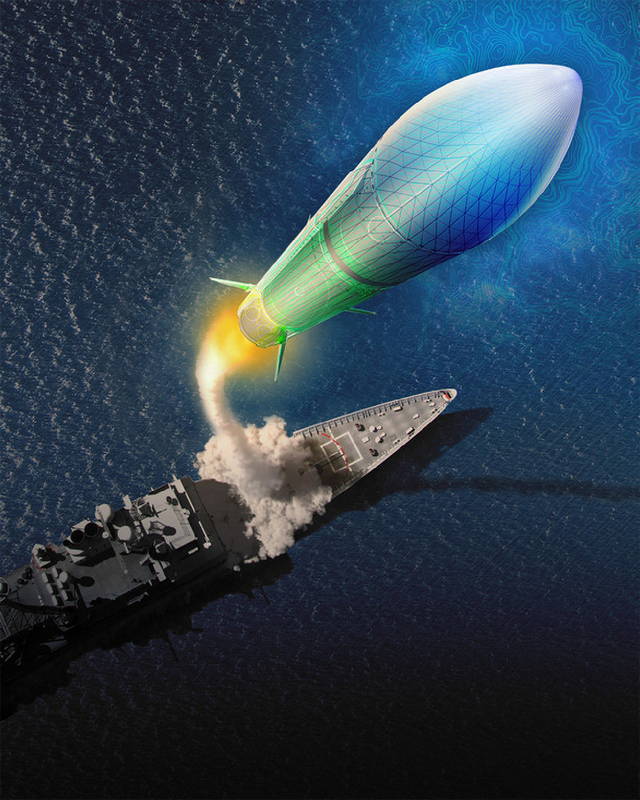
Conceptual design of the DDG (X) arsenal
According to B. Guarini, the US Navy is developing energy reserves for future surface warships capable of providing "subsequent integration of powerful sensors and directional energy effectors." He added that an integrated power supply system will be crucial for managing power surges and leaks.
Energy of the future
George Awiszus, director of marketing at GE Marine, said that next-generation destroyers will need "significantly more electricity" to move, which can be scaled to meet the future growth in energy demand for sensors and weapons that the Navy wants to use.
Unlike the power system used on Arleigh Burke-class destroyers, where large turbines directly drive propellers and individual turbines generate electricity, all turbines of the new destroyer will produce electricity, which is then fed to the power plant and other systems.
"This [energy system] provides significant operational benefits, performance, flexibility, accessibility, efficiency and reliability. Through the ship's electrical network, energy can be easily transferred to where it is needed, without the need to turn on/off the equipment," D. Avishus noted.
GE Marine, together with its subsidiary GE Power Conversion, already supplies integrated power and propulsion systems for the Daring Type 45 destroyers, the Queen Elizabeth aircraft carriers and the Zamvolt project destroyers of the US Navy.
During the 2020 Surface Fleet Symposium, the Chief of Naval Operations of the US Navy, Rear Admiral Paul Schlise, stated that DDG (X) would have an integrated power system similar to Zamvolt. As the Navy plans to purchase the first new DDG(X) destroyer in 2028, the service has already held an industry day. As reported by J.Avishus, Navy cooperates with GE and other suppliers in the field of engine research.
Meanwhile, GE is offering South Korea an all-electric propulsion system for the KDDX project, similar to the one used on the Royal Navy's Type 45. The installation consists of an LM2500 series gas turbine, a GE Power Conversion generator, power motors and drives. Avishus added that the selection of a gas turbine for this program is planned for the coming year.
"Ships are likely to continue to use energy-efficient, higher-voltage power architectures to meet growing energy needs, supported by innovations in advanced power electronics and high-performance materials."… We also expect greater integration with digital ship networks, improved automation and control, as well as more autonomous systems supporting the crew and controlling the power grid in line with the increased speed of next—generation consumer machines," said J.Avishus.
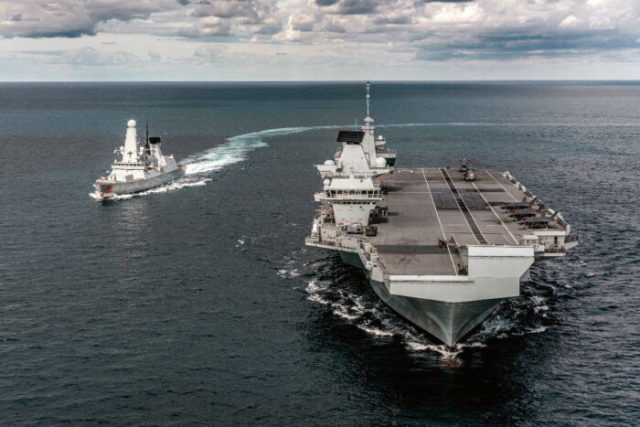
GE Marine supplies integrated power and propulsion systems for British aircraft carriers of the Queen Elizabeth type
He explained that increasing power requirements increase the importance of efficiency and flexibility, as these factors will allow ships to remain on alert for as long as possible. He added that energy storage will provide flexibility for "peak power needs," ensure the stability of the electric bus and reduce the need for "separate smaller uninterruptible power supplies."
GE Power Conversion worked with the U.S. Navy's Office of Naval Research to create a hybrid energy storage system. "Finally, the Navy is increasingly aware of the need to reduce the risk of new power plants. This includes modeling and simulation, as well as full—scale testing of a similar and/or final equipment configuration," added J.Avishus.
U.S. lawmakers, as part of defense funding legislation to reduce the risks of the program's energy system before it is sent to sea, have pushed the U.S. Navy to develop a ground-based test facility for the new DDG(X) destroyer.
Autonomy and networks
Jake Rigby, head of defense and security research and development at BMT [British Maritime Technology], said that future destroyers such as the Type 83 are likely to receive a higher level of autonomy and greater dependence on digital systems.
"Automation of many systems currently controlled by the crew will bring significant benefits to the user community and will allow the Navy to better understand the means and motives of potential adversaries and reduce the risk of attack," explained J.Rigby.
He said the defense procurement communities are "well versed" in the opportunities that automation offers, citing investment, research and development in this area. He added that the so-called "Security by Design" principles should be used ['Secure by Design'] to ensure that problems are addressed at an early stage of design.
"Along with a holistic view of safety risk in the context of the operational capabilities and physical limitations of the system, this will ensure an appropriate balance of risks while maximizing the operational advantage provided by the ship," said J.Rigby.
AI [artificial intelligence] and machine learning as part of the fleet of the future is not a new concept: in November 2020, the UK's Defense Science and Technology Laboratory allocated 3 million pounds (4 million US dollars) to nine companies as part of its Smart Ship project [Intelligent Ship]. The program explored how AI and humans could work together to spread C2 [command and control] and generate faster and more efficient decision-making.
BMT has reportedly developed a plan to introduce technologies that will ensure highly autonomous operations in the future. Looking at this vision, J. Rigby said, "We are exploring technologies such as deep learning, which allows machines to absorb huge amounts of data with very complex relationships and analyze information to find trends and provide information and intelligent data... Decision-making processes like this will play an important role in the autonomy of the ocean. and based on the time schedule, deep learning could potentially be at the verification and testing stage in 2025. For comparison, automated fire extinguishing systems and autonomous mechanism control systems have already passed the verification and testing stage and can be integrated into ship designs relatively soon."
GE's F7 offers South Korea an all-electric propulsion system for the KDDX project
From a network point of view, while the United States has lofty goals for efforts such as Joint All-Domain Command and Control, at the system level, active and passive ground sensors in different ranges will be networked between domains, "expanding the operational area and sensor ranges and long–range effectors," J. Guarini said.
"The modular architecture of modern marine radars allows updating software and hardware to stay ahead of the threat. The underwater network is just as important as displaying the situation on the surface. To keep up with the global growth in the number of manned submarines and unmanned underwater vehicles, an integrated multi—domain anti-submarine network and mobile sensors with high-performance shipboard sonars, in particular variable depth sonars, capable of providing an extended detection range below the thermal layer, are required," he added.
Keep up
Despite the military's best efforts to become more flexible in the face of new technologies, ship construction is still a lengthy process. There are often many technological changes on the timeline from concept to commissioning.
Asked how the pace of change would affect the design, J. Guarini said: "The U.S. Navy, as well as the world's navies, are aware that power, weight and space reserves are necessary to ensure that ships keep up with changing threats and can increase or change mission capabilities during the lifetime of the ship class. For example, today's [Arleigh Burke] Flight III ships are very different and significantly more efficient than the original Flight I ships. Therefore, future ships will be designed and built with a margin to change and improve capabilities and requirements."
Looking at DDG(X), in order to succeed, the US Navy will need to chart a steady course between new technologies that provide a military advantage and proven systems so as not to repeat the problems associated with the adoption of the Zamvolt type. Combining new technologies with proven systems and repeating the design is likely to be a key indicator of the success of the new US Navy destroyer when it enters production.
While the Royal Navy is exploring modular platforms for lower-level warships in the fleet, such as the future Inspiration Project frigates Type 31 and Type 32, UK officials have said that the Type 83 is likely to be a more refined platform. This indicates the often defined role of the project in modern fleets and the importance of its specific roles.
With the more promising Type 83, it becomes possible to explore conceptual technologies and ideas that will not mature for many more years. While this will undoubtedly lead to the creation of a functional platform, it also carries the risk that some technologies will not develop properly, which may affect later stages of the program.
Commenting on the direction of movement of the new destroyers, J. Rigby said that BMT expects a wider introduction of onboard systems with a higher level of automation and systems with a high level of trust on board naval ships over the next 20 years.
He added that "certain operational and decision-making functions" will still require human interaction, especially in areas where ethical considerations and operational complexity are important, and where autonomous systems pose "more of a risk than an advantage."
However, several trends are likely to determine the design, for example, the need for integrated energy supply solutions and network capabilities, both for short-term programs and for more distant ones. While autonomy, AI, and machine learning are often used as buzzwords, their integration into projects will provide new opportunities for the Navy and issues of trust and where the line of human engagement can be drawn.
THE MAIN CONCLUSIONS:
- Future surface warships will be able to provide C2 for a crewless fleet.
- Hypersonic weapons are increasingly attracting the attention of the armed forces.
- There is currently a continuing need for advanced cruise missiles in addition to hypersonic missiles.
- The next generation of destroyers will require significantly more electricity to move.
- The new destroyers are likely to have a higher level of autonomy and greater dependence on digital systems.
Based on the materials of the resource shephardmedia.com
